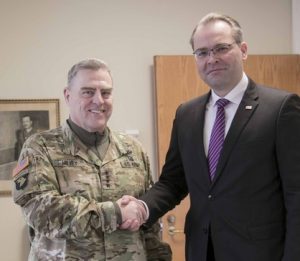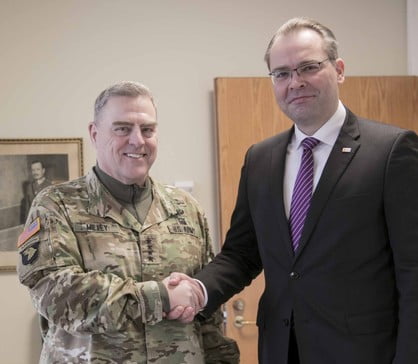2018-02-11 Recently, the Finnish Minister of Defence Jussi Niinistö met with Commander of the United States Army, General Mark A. Milley in Helsinki.
According to a press release on the Finnish MoD website:
Earlier General Milley followed a readiness unit’s live fire exercise at the Karelia Brigade.
The visit is hosted by Commander of the Finnish Army, Major General Petri Hulkko.
And earlier in an article published on February 2, 2018, the Finnish MoD website announced a recent acquisition agreement involving the Finnish ground forces:
The Finnish Defence Forces’ Logistics Command received a mandate, on 29.1.2018, from Defence Minister Jussi Niinistö to conclude a contract with the United States government to procure training munitions.

The contract comprises the procurement of practice rockets and a related package of technical information.
The munitions are manufactured by Lockheed Martin in the United States.
The Low Cost Reduced Range Practice Rocket (LCRRPR) is a practice rocket fired with a MLRS launcher.
The practice rockets are in a Rocket Pod Containers (RPC) that is standardised to be used on a heavy rocket launcher (MLRS and HIMARS).
The procurement that ensures continued training and appropriate exercises is a joint procurement with the United States from where Finland procures certified munitions in production.
The manufacturer of LCRRPR munitions and the heavy rocket launcher is the same, Lockheed Martin in the United States.
The procurement is a part of the overall development of the joint battle system in the Finnish Defence Forces, with the overall value of about EUR 6.2 million. The exercise munitions will be delivered in 2019.
When one sees a visit like this one, it can be overlooked that as the US services look to transform the joint force going forward they have a lot in common with partner and allied forces seeking to do the same in support of their own national interests and strategy.
In the Finnish Defence Report published last year, the Finns have put the challenge facing the US, partners and allies very clearly: “the early warning period for military crises has shortened and the threshold for using force has become lower.”
The US Army Chief of Staff certainly gets that and his tasking to the Army and its transformation is to do a better job in operating in such a strategic environment.
When we interviewed BG McIntire, the key advisor to the COS of the Army on ADA, this is what he had to say about the Chief’s priorities:
BG McIntire: “The Chief of Staff of the U.S. Army has highlighted a number of key priorities for Army modernization.
“The first priority is to fix long-range strike.
“Second, we need the next generation combat vehicle and one which enables the offensive-defensive approach to Large Scale Combat Operations.
“Third, we need a new vertical lift capability. We need a much higher speed helicopter capability and one that can operate effectively in the 21st century multi-domain maneuver space.
“Fourth, we need to have a better open architecture network. We need to work on our C2 and we need a transformation of our mission command system.
“But without effective defense in the maneuver force, you’re not going to be able to survive. Air Defense is a key enabler for the maneuver force.
“Survivability of the maneuver force requires an organic air missile defense as well as extended defense for the integrated battlefield.
“It is not an afterthought; it is a core requirement of mission success.”
BG McInture emphasized that integrated fires are the key to breaking up adversary efforts to shape anti-access and area denial of operational areas.
It is clear that Finns also get this, as their Finnish defense document discusses the importance of enhanced defense which has the capability to defend against longer range strike and to also have their own longer range strike capability.
In other words, cross-learning is both necessary and inevitable.
It is about the US, partners and allies working together to enhance deterrence.
As the Finnish report on defense puts it clearly: “Deterrence relies on the kind of readiness and capability to repel attacks which is appropriately tailor to its operating environment…Finland will create the ability to provide and receive military assistance….This calls for collaboration in planning, shared situation awareness, compatible C2 and surveillance systems as well as training and exercise cooperation and interoperability.”
The recent visit is part of such an effort.
https://defmin.fi/files/3688/J07_2017_Governments_Defence_Report_Eng_PLM_160217.pdf


